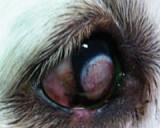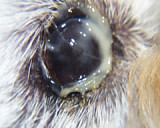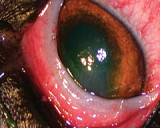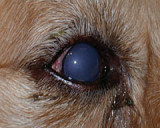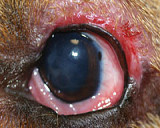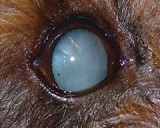Corneal Lipid Info
There are different types of corneal lipid seen in dogs. These include breed related, keratopathies, pannus, episcleritis and degenerative corneal lipid seen in elderly dogs. Cyclosporin has been recognised as a drug that can ‘stabilise’ corneal lipid and in many cases stop it from progressing. It is also been recognised that topical cortisone drops can worsen corneal lipid, so it is ideal to treat keratitis cases with the minimal frequency that controls the inflammation, and use concurrent Cyclosporin. In severe cases where vision is affected or ulcers are not healing quickly, a diamond burr can be used to remove some of the corneal lipid and encourage corneal ulcers to heal.
Keratopathy / scarring post corneal ulceration
Keratopathy or scarring post corneal ulceration: Varying degrees of scarring with lipid is possible following any inflammatory corneal disease or corneal ulceration. Lipid deposition may follow ulceration, any keratitis or punctate keratitis. In these cases,1% Cyclosporin drops may be used twice daily until inflammation has resolved. Treatment may be required once daily long term if inflammation is persistent or recurs. Concurrent topical cortisone may be used if there is no ulceration and the cornea appears healthy enough.
Pannus
Pannus: Corneal lipid is a common sequel to superficial stromal keratitis cases. It also commonly occurs when long term topical cortisone drops have been used. Most Pannus cases are best controlled with a combination of topical cortisone and Cyclosporin including Optimmune ointment. This topical Cyclosporin generally helps control the corneal lipid.
Episcleritis
Episcleritis: Corneal lipid commonly develops in the peripheral cornea adjacent to the area of sclera that was swollen and inflamed. It is usually dense and focal. In some cases blood vessels extend towards it and the eye can be inflamed due to keratitis. Many cases of episcleritis require ongoing topical cortisone drops, and in cases where corneal lipid develops, concurrent Cyclosporin is recommended.
Degenerative corneal lipid
Degenerative corneal lipid: This is a syndrome seen in older dogs, typically 15yo+ Poodles, Pomeranians, Maltese and crosses of these breeds. On examination, degenerative lipid is present axially that looks as if it is calcified or crystalline. When this is seen in elderly patients, topical Cylosporin should be commenced e.g. Optimmune SID to BID or 1% Cyclosoprin drops at the same dose. Tacrolimus 0.2% drops may be used if Cyclosporin is irritant to the eye. These corneas commonly ulcerated and they often appear as though a piece of the lipid has fallen out, and a deep hole may be present. If ulceration is present, Doxycycline at 2.5-5mg/kg BID should be commenced, plus appropriate pain management e.g. Tramadol in very old dogs. If the ulcer has sharp edges, epithelialisation may be inhibited, and burring the cornea under topical anaesthetic can be performed. If the ulcer is very deep or fails to heal, conjunctival pedicle grafting is performed. We try to avoid this where possible due to the effect on vision.
